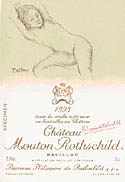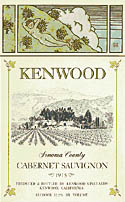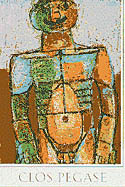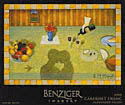September 1998
Pages 54-55
 Kiddie porn? Smut? The cause of violence against women? Evil? Is this the latest in anti-television campaigns? An attempt to shut down the neighborhood adult video store? A protest at the local porn theater? Maybe it’s just a bottle of wine.
Kiddie porn? Smut? The cause of violence against women? Evil? Is this the latest in anti-television campaigns? An attempt to shut down the neighborhood adult video store? A protest at the local porn theater? Maybe it’s just a bottle of wine.
Surely, back in 1945 when Baron Phillipe de Rothschild created the first “art labels” for Chateau Mouton Rothschild wines, he never had this level of controversy in mind. Over the years the chateau’s wines have featured art from such notables as Dali, Picasso, and Miro. From our own community, works by Andy Warhol (1975) and Keith Haring (1988) have graced the labels of what is one of the world’s greatest, and most expensive, wines.
 Dressing up a bottle in the fashions of some of the world’s greatest artists and designers has caught on like wildfire. Until just a decade or so ago, few besides Mouton Rothschild in Bordeaux and the Vietti family in Piedmont went to the expense and difficulty of coordinating such projects. For the most part, the labels were simple celebrations of the world of wine and food – Mouton had no serious difficulties distributing its wines until 1993, 48 years after their series started. A Balthus sketch of a nude, adolescent female in a suggestive pose started a controversy that caught worldwide attention. The even more suggestive prose that accompanied it brought out activists left and right. Balthus is, admittedly, a controversial artist to begin with–known for his drawings of children experiencing “erotic awakenings.” A group calling themselves “Concerned Adults,” based in Napa Valley, collected hundreds of protest signatures; calling attention to a label they claimed could have come from “the kiddie porn channel.” (Napa Valley apparently has rather comprehensive cable service.) The Mouton response? Continue marketing the wine as is outside the U.S., and send a label with a blank, censored space, to our shelves. Needless to say, the original label quickly became a hot collector’s item.
Dressing up a bottle in the fashions of some of the world’s greatest artists and designers has caught on like wildfire. Until just a decade or so ago, few besides Mouton Rothschild in Bordeaux and the Vietti family in Piedmont went to the expense and difficulty of coordinating such projects. For the most part, the labels were simple celebrations of the world of wine and food – Mouton had no serious difficulties distributing its wines until 1993, 48 years after their series started. A Balthus sketch of a nude, adolescent female in a suggestive pose started a controversy that caught worldwide attention. The even more suggestive prose that accompanied it brought out activists left and right. Balthus is, admittedly, a controversial artist to begin with–known for his drawings of children experiencing “erotic awakenings.” A group calling themselves “Concerned Adults,” based in Napa Valley, collected hundreds of protest signatures; calling attention to a label they claimed could have come from “the kiddie porn channel.” (Napa Valley apparently has rather comprehensive cable service.) The Mouton response? Continue marketing the wine as is outside the U.S., and send a label with a blank, censored space, to our shelves. Needless to say, the original label quickly became a hot collector’s item.
 Other producers have faced similar difficulties. In 1971, the Vietti family, producers of stellar Barbarescos and Barolos, began commissioning artists for special reserve wines in certain years. The first label, a sketch by artist Claudio Bonichi of a nude woman being carried off by a nude man during the historical rape of the Sabines, was banned from the U.S. and the wine was never distributed here.
Other producers have faced similar difficulties. In 1971, the Vietti family, producers of stellar Barbarescos and Barolos, began commissioning artists for special reserve wines in certain years. The first label, a sketch by artist Claudio Bonichi of a nude woman being carried off by a nude man during the historical rape of the Sabines, was banned from the U.S. and the wine was never distributed here.
California producers have jumped on the bandwagon of art labels. Kenwood Vineyards has an artist’s series reserve Cabernet Sauvignon that is excellent. From day one, Kenwood had difficulty–the first label, in 1975, depicted a reclining naked woman as painted by San Francisco artist David Goines. The government agency that approves or disapproves labels, the Bureau of Alcohol, Tobacco and Firearms (a rather interesting juxtaposition of regulated items, no?), gave a resounding “no”. Kenwood’s response was to resubmit the painting with the woman as a skeleton. The BATF re-rejected it, claiming it mocked the dangers of Fetal Alcohol Syndrome. Interestingly, the owners of Kenwood were among the most vocal critics of the Chateau Mouton label; though in fairness, their protest was over the adolescence of the model, not the nudity.
 Similarly, the owner of Clos Pegase winery faced controversy over its 1988 Hommage Red wine label that showed a semi-abstract male nude. The end result of a BATF rejection on grounds of indecency–a cropped image that eliminated the nude’s genitals. Though the wine was distributed this way the owner continued a court battle, winning three years later by “proving” that the label was art, by a recognized, known artist (French painter Jean Dubuffet) and therefore exempt from regulations prohibiting nudity in advertising.
Similarly, the owner of Clos Pegase winery faced controversy over its 1988 Hommage Red wine label that showed a semi-abstract male nude. The end result of a BATF rejection on grounds of indecency–a cropped image that eliminated the nude’s genitals. Though the wine was distributed this way the owner continued a court battle, winning three years later by “proving” that the label was art, by a recognized, known artist (French painter Jean Dubuffet) and therefore exempt from regulations prohibiting nudity in advertising.
The popular wines of Clos du Val are recognized on shelves nationwide. And anyone who knows the label is unlikely to call it obscene. The winery decided to go for a label that used some truly historical art: a sketch by British engraver Leo Wyatt of a 1624 Petel sculpture of the three graces (Splendor, Mirth & Good Cheer) who didn’t happen to be wearing clothes. The label was approved in 1974, then the approval was rescinded and rejected three times, finally winning re-approval in 1990.
 Needless to say, not all artist series labels are controversial. The five wineries discussed above have long histories of using artwork that hasn’t caused a stir. Other wineries have similar programs. Chateau Ste. Michelle of Washington state uses stylized depictions of glass sculptures by some of the world’s greatest craftsmen. Benziger Vineyards has its Imagery Series, a celebration of some of the world’s top artists, on its single varietal wines. Mumm Cuvee Napa had fashion designer Nicole Miller design their premium release bottle to try to attract the “fashion- conscious younger generation.”
Needless to say, not all artist series labels are controversial. The five wineries discussed above have long histories of using artwork that hasn’t caused a stir. Other wineries have similar programs. Chateau Ste. Michelle of Washington state uses stylized depictions of glass sculptures by some of the world’s greatest craftsmen. Benziger Vineyards has its Imagery Series, a celebration of some of the world’s top artists, on its single varietal wines. Mumm Cuvee Napa had fashion designer Nicole Miller design their premium release bottle to try to attract the “fashion- conscious younger generation.”
Even beer producers have gotten in on the act with a variety of nudes that range from tasteful to questionable. The state of Pennsylvania has declared a reproduction of Brussels’s famous “Mannekin Pis,” or boy peeing, statue as “rude and offensive” and refuses to allow Paulaner’s new beer into the state. The aptly named “Wanker” beer labels are, perhaps, designed with solo beer drinking in mind.
 As in all art, not only beauty, but pornography is in the eye of the beholder. Wineries will continue to commission artists to create labels. Some may be beautiful, some may be pornographic. It is, perhaps, amusing to think of vintners as visionaries in the mores of our culture; I prefer to think of them as visionaries in the world of taste. But next time you reach for that pretty bottle you may not just be getting good wine to drink – you may be collecting art and you may be collecting history.
As in all art, not only beauty, but pornography is in the eye of the beholder. Wineries will continue to commission artists to create labels. Some may be beautiful, some may be pornographic. It is, perhaps, amusing to think of vintners as visionaries in the mores of our culture; I prefer to think of them as visionaries in the world of taste. But next time you reach for that pretty bottle you may not just be getting good wine to drink – you may be collecting art and you may be collecting history.
Q San Francisco magazine premiered in late 1995 as a ultra-slick, ultra-hip gay lifestyle magazine targeted primarily for the San Francisco community. It was launched by my friends Don Tuthill and Robert Adams, respectively the publisher and editor-in-chief, who had owned and run Genre magazine for several years prior. They asked me to come along as the food and wine geek, umm, editor, for this venture as well. In order to devote their time to Passport magazine, their newest venture, they ceased publication of QSF in early 2003.